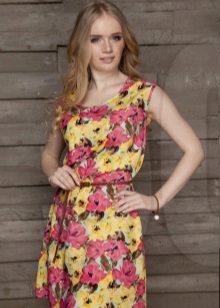Poplin is a material that is quite rarely found in the description of the composition of clothes, much more often it is used in the manufacture of home textiles. However, sometimes in stores there are dresses, blouses, shirts and other things from this fabric.



Undeservedly forgotten, poplin has excellent quality characteristics, which we will discuss in more detail below.
The name of this material is of Italian origin. Translated from the language of Dante, it means "papal", and is associated with none other than the Pope. The fact is that initially poplin was produced in one of the papal residences, which was located in France - hence the unusual name of the fabric.



In this article, we will tell you about poplin dresses: about the advantages and disadvantages of this clothing, about its fashionable variations and about how it should be looked after.

Pros and cons of poplin
Despite the fact that modern poplin is made using a completely different technology than centuries ago, it managed to maintain all its characteristics, thanks to which this fabric was in demand.



The advantages of this material include:
- ability to maintain shape for a long time;
- ease of coloring and, as a result, a variety of colors;
- strength and wear resistance;
- simplicity in leaving;
- ability to keep warm;
- relative cheapness;
- environmental friendliness and hypoallergenicity;
- predominantly natural composition;
- high degree of breathability;
- ability to quickly absorb moisture.



The drawbacks of poplin are much less than the advantages:
- poplin is quite hard, therefore not suitable for people with sensitive skin;
- cheap poplin is poorly painted, so it quickly loses color.



Structure
The composition of poplin, however, like most other tissues, has undergone significant changes over time. When this fabric first appeared, it was made from natural silk fibers.
Modern poplin has a predominantly mixed composition. Silk among the components has become a rarity, much more often wool, cotton, and sometimes synthetic fibers are present in the fabric.
If we are talking about poplin bedding, then it is usually made of 100% cotton.



Specialists distinguish several varieties of poplin, depending on the composition and type of weaving: silk, semi-silk (a combination of a silk base and a wool "duck" - transverse threads) and cotton.




Varieties of poplin vary, including the size of the scar. The most popular dresses in a shallow hem.

Styles
Poplin dresses were once the prerogative of noble ladies, and now this fabric is so affordable that absolutely any girl can afford a poplin outfit. Not finding in the store a suitable model of a poplin dress, the craftswomen often sew it themselves, since this material is easy to hide and does not create difficulties in work.



Since the fabric itself is quite unpretentious, dresses from it are not suitable for special occasions - they are more suitable for everyday life. Poplin dresses of the simplest cut look best: tunics, shifts, sundresses, bags, and the like. Any length is acceptable: a dress in a floor in a folk style and a very short dress with a high waist in a baby-dollar style will look equally good.



Summer models
Since this material passes air well and absorbs moisture, it is mainly used for sewing summer dresses. Such an outfit will allow you to feel comfortable in the heat, and will not constrain movements.
Poplin dresses are very comfortable and light. Styles can be varied, but laconic models, in which the simplicity of the silhouette is compensated by bright colors, are most popular. Poplin drapes well, gently flowing, so he looks great on skirts. Poplin models in retro style are popular: with a tight bodice, a crew neck, a small sleeve and a fluffy bell skirt.






We also recommend that you pay attention to practical shirt dresses and light poplin sundresses.
Care
High-quality poplin is very undemanding in care: it can be washed in a washing machine at any temperature and dried in a drum. In addition, such things do not need to be ironed, because after washing they themselves restore shape.




The problem is that today it is quite difficult to find a product of high quality poplin, therefore, if the material is in doubt, some precautions should be observed:
- Wash the dress at a temperature of 30 to 60 degrees.
- To remove complex contaminants, it is permissible to briefly raise the water temperature to 90 degrees.
- Dry in a place where direct sunlight does not penetrate.
- If there is a need for ironing - put the iron in the "cotton" mode.











